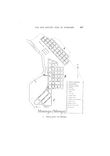...
Historical images Moengo

Map of Moengo with the segregated neighbourhoods, drawn by Dentz in 1925

The Creole neighbourhood when Moengo was being built. In the background, the more luxurious homes of the Americans are visible

Just like during the Covid-19 epidemic, travel in 1926 was limited due to health concerns; back then, typhus was the cause

Letter announcing that permission had been granted to the Americans to mine bauxite. Bauxite was discovered in 1916, but the Netherlands did not grant mining permission until 1924, and only provided that a Dutch director would be appointed in Suriname. This was a result of the Dutch feeling that the Americans present in Suriname were not properly abiding to colonial rules

Article from the Suralco company newsletter from 1982. For a long time, there was no direct route from Paramaribo to Moengo. Later the East-West connection was built. Its construction began in the 1960s. Until the 1980s, there was a ferry to cross the river Cottica. Then Suralco built a bridge. However, during the Interior War, this bridge was blown up by Ronnie Brunswijk, in order to hold back Desi Bouterse's soldiers. Since then, a new bridge has been built

Casa Blanca around 1932. Until the 60s, this was the director's residence. After that it became a social club for the staff members

The staircase inside Casa Blanca was a popular spot to pose for pictures. When the young Moengonese photographers arrived at Casa Blanca with their cameras in 2018, they spontaneously began to pose and photograph each other on the stairs. On the left is Jerusa

Audience at a speech for the opening of a new SBM building in Moengo, 1947. Segregation is visible in the audience's seating arrangement

The swimming pool in Stafdorp

Moengo in the 1920s. The town is only half-built, but the tennis court is already there

The tennis court in use, in the 1920s

While Suralco staff members had long had access to a swimming pool, the workers were not allowed to use it. In the 1960s, therefore, the workers constructed a pool of their own

Suralco built a hospital as well, with a seperate entrance for staff members. The doctors and nurses were paid by the staff members. After Suralco left, artist Marcel Pinas turned the hospital into an art centre
The Beatrix Theatre in 1966. Everyone was welcome, but of course your status determined your seating. After the Interior War, the Beatrix Theatre was used as a pornographic movie theatre for a while. Now, it's abandoned

A typical worker's residence on poles

A Roman Catholic church and a Moravian Church church next to each other, 1946

The colonial leadership's conditions under which the workers were rented out to Suralco

With the arrival of Javanese indentured servants, elements from Javanese culture were incorporated in Surinamese culture, including gamelan music

A Javanese family in Moengo. At first, Javanese indentured servants and Creole workers lived in separate neighbourhoods

Looking out over the Suralco factory grounds

Cargo ship for bauxite transport at the dock in Moengo, before 1947

Group photo of the factory workers, 1925-1927

A shovel loads ore into a tipping trailer on the SBM grounds in Moengo, 1955

Workers in Moengo, 1929-1930

SBM's official residence in Stafdorp

Looking out over the southern part of the workers' residences from the water tower. In front are the store, school, and hospital buildings, 1925